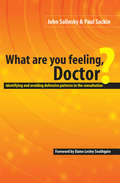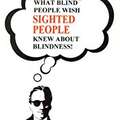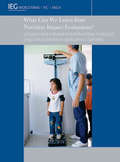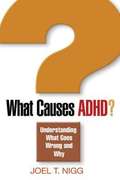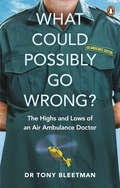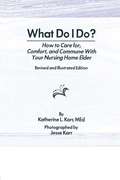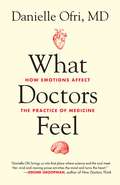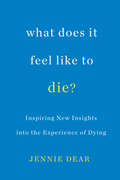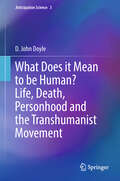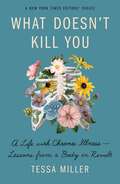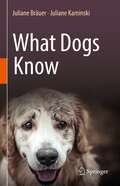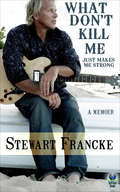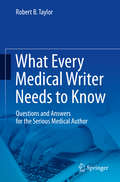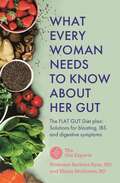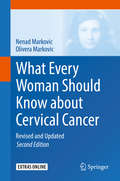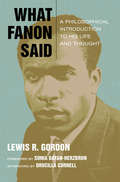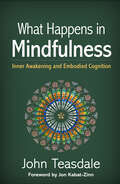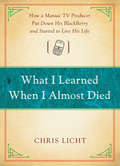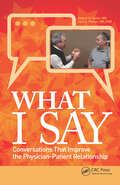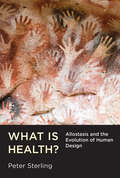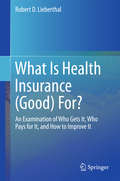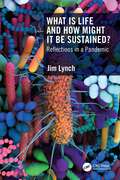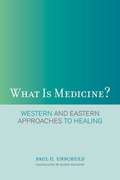- Table View
- List View
What are You Feeling Doctor?: Identifying and Avoiding Defensive Patterns in the Consultation
by John Salinsky Paul SackinGuidelines are powerful instruments of assistance to clinicians capable of extending the clinical roles of nurses and pharmacists. Purchasers and managers perceive them as technological tools guaranteeing treatment quality. Guidelines also offer mechanisms by which doctors and other health care professionals can be made more accountable to their patients. But how can clinicians tell whether a guideline has authority and whether or not it should be followed? Does the law protect doctors who comply with guidelines? Are guideline developers liable for faulty advice? This timely book provides a comprehensive and accessible analysis of the many medical and legal issues arising from the current explosion of clinical guidelines. Featuring clear summaries of relevant UK US and Commonwealth case law it is vital reading for all doctors health care workers managers purchasers patients and lawyers.
What Blind People Wish Sighted People Knew About Blindness! (Revised Edition)
by Harry Martin<P>Harry Martin became blind as the result of an eye disease he contracted while serving in the Navy in 1973. His eye condition began as a case of severe visual impairment, and progressed to total blindness over a period of twenty years. Harry lives with his wife, Carol, and his guide dog, Frankie in Orlando, Florida. <P>THIS BOOK IS A MUST READ FOR ALL SIGHTED PEOPLE! <P>Whether you know a blind person or not, you must read this book. The reader will gain a new understanding of what it is like to be blind, and to go blind. Find out why some blind people can see. Learn how guide dogs work. Discover how blind people do things without sight. If you have a blind relative, friend, spouse, or co-worker; this fascinating book will tell you how to relate to them better. Teachers, this book is an outstanding educational tool. Use it to teach your students all about blindness and the blind.
What Can We Learn from Nutrition Impact Evaluations?
by Martha AinsworthWhat Can We Learn from Nutrition Impact Evaluations? High levels of child malnutrition in developing countries contribute to mortality and have long-term consequences for children's cognitive development and earnings as adults. Recent impact evaluations show that many different interventions have had an impact on children's anthropometric outcomes (height, weight, and birth weight), but there is no simple answer to the question "What works?" to address the problem. Similar interventions have widely different results in different settings, owing to differences in local context, the causes and severity of malnutrition, and the capacity for program implementation. Impact evaluations of programs supported by the Bank, which are generally large-scale, complex interventions in low-capacity settings, show equally variable results. The findings confirm that it should not be assumed that an intervention found effective in a randomized medical setting will have the same effects when implemented under field conditions. There are many robust experimental and quasi-experimental methods for assessing impact under difficult circumstances often found in field settings. The relevance and impact of nutrition impact evaluations could be enhanced by collecting data on service delivery, demand-side behavioral outcomes, and implementation processes to better understand the causal chain and what part of the chain is weak, in parallel with impact evaluations. It is also important to understand better the distribution of impacts, particularly among the poor, and to document better the costs and effectiveness of interventions. High levels of child malnutrition in developing countries are contributing to mortality and present long-term consequences for the survivors. An estimated 178 million children under age 5 in developing countries are stunted (low height for age) and 55 million are wasted (low weight for height). Malnutrition makes children more susceptible to illness and strongly affects child mortality. Beyond the mortality risk in the short run, the developmental delays caused by undernutrition affect children's cognitive outcomes and productive potential as adults. Micronutrient deficiencies-vitamin A, iron, zinc, iodine, for example-are also common and have significant consequences. Progress in reducing malnutrition has been slow: More than half of countries are not on track to achieve the Millennium Development Goal of halving the share of children who are malnourished (low weight for age) by 2015. The food price and financial crises are making achievement of this goal even more elusive. The World Bank has recently taken steps to expand its support for nutrition in response to the underlying need and the increased urgency due to the crises.
What Causes ADHD?
by Joe Seargent Joel NiggSynthesizing a wealth of recent neuropsychological research, this groundbreaking book focuses on the multiple pathways by which attention-deficit/hyperactivity disorder (ADHD) develops. Joel T. Nigg marshals the best available knowledge on what is actually going on in the symptomatic child's brain and why, tracing the intersecting causal influences of genetic, neural, and environmental factors. In the process, the book confronts such enduring controversies as the validity of ADHD as a clinical construct. Specific suggestions are provided for studies that might further refine the conceptualization of the disorder, with significant potential benefits for treatment and prevention.
What Could Possibly Go Wrong?: The Highs and Lows of an Air Ambulance Doctor
by Dr Tony Bleetman'During open-chest resuscitations, I've held a non-beating, recently stilled human heart in my hands. And, should you ever get to hold one, you will find the human heart to be rubbery and shockingly light.'What Could Possibly Go Wrong? is a report from the front line of emergency medicine, the first ever account of what it is like to work as an air ambulance doctor. Whether describing cutting through a patient's breastbone to plug a stab wound or barrel rolling a light aircraft at 5,000 feet, Tony Bleetman captures the sheer adrenaline of racing through the sky to save lives. You will learn how to land a helicopter on the side of a mountain, what it means to encounter death every day, and how to perform a tracheotomy in real life (clue: it doesn’t involve a ball-point pen).Funny, shocking and moving, What Could Possibly Go Wrong? is a glimpse at a world where the wrong decision can mean the difference between life and death.Originally published as You Can't Park There: The Highs and Lows of an Air Ambulance Doctor.
What Do I Do?: How to Care for, Comfort, and Commune With Your Nursing Home Elder, Revised and Illustrated Edition
by Katherine Karr Jess KarrHelp families of institutionalized elders with this compassionate and practical manual.
What Doctors Feel: How Emotions Affect the Practice of Medicine
by Danielle OfriA look at the emotional side of medicine—the shame, fear, anger, anxiety, empathy, and even love that affect patient care Physicians are assumed to be objective, rational beings, easily able to detach as they guide patients and families through some of life’s most challenging moments. But doctors’ emotional responses to the life-and-death dramas of everyday practice have a profound impact on medical care. And while much has been written about the minds and methods of the medical professionals who save our lives, precious little has been said about their emotions. In What Doctors Feel, Dr. Danielle Ofri has taken on the task of dissecting the hidden emotional responses of doctors, and how these directly influence patients. How do the stresses of medical life—from paperwork to grueling hours to lawsuits to facing death—affect the medical care that doctors can offer their patients? Digging deep into the lives of doctors, Ofri examines the daunting range of emotions—shame, anger, empathy, frustration, hope, pride, occasionally despair, and sometimes even love—that permeate the contemporary doctor-patient connection. Drawing on scientific studies, including some surprising research, Dr. Danielle Ofri offers up an unflinching look at the impact of emotions on health care. With her renowned eye for dramatic detail, Dr. Ofri takes us into the swirling heart of patient care, telling stories of caregivers caught up and occasionally torn down by the whirlwind life of doctoring. She admits to the humiliation of an error that nearly killed one of her patients and her forever fear of making another. She mourns when a beloved patient is denied a heart transplant. She tells the riveting stories of an intern traumatized when she is forced to let a newborn die in her arms, and of a doctor whose daily glass of wine to handle the frustrations of the ER escalates into a destructive addiction. But doctors don’t only feel fear, grief, and frustration. Ofri also reveals that doctors tell bad jokes about “toxic sock syndrome,” cope through gallows humor, find hope in impossible situations, and surrender to ecstatic happiness when they triumph over illness. The stories here reveal the undeniable truth that emotions have a distinct effect on how doctors care for their patients. For both clinicians and patients, understanding what doctors feel can make all the difference in giving and getting the best medical care.
What Doctors Feel
by Danielle OfriA look at the emotional side of medicine--the shame, fear, anger, anxiety, empathy, and even love that affect patient care Physicians are assumed to be objective, rational beings, easily able to detach as they guide patients and families through some of life's most challenging moments. But doctors' emotional responses to the life-and-death dramas of everyday practice have a profound impact on medical care. And while much has been written about the minds and methods of the medical professionals who save our lives, precious little has been said about their emotions. In What Doctors Feel, Dr. Danielle Ofri has taken on the task of dissecting the hidden emotional responses of doctors, and how these directly influence patients. How do the stresses of medical life--from paperwork to grueling hours to lawsuits to facing death--affect the medical care that doctors can offer their patients? Digging deep into the lives of doctors, Ofri examines the daunting range of emotions--shame, anger, empathy, frustration, hope, pride, occasionally despair, and sometimes even love--that permeate the contemporary doctor-patient connection. Drawing on scientific studies, including some surprising research, Dr. Danielle Ofri offers up an unflinching look at the impact of emotions on health care. With her renowned eye for dramatic detail, Dr. Ofri takes us into the swirling heart of patient care, telling stories of caregivers caught up and occasionally torn down by the whirlwind life of doctoring. She admits to the humiliation of an error that nearly killed one of her patients and her forever fear of making another. She mourns when a beloved patient is denied a heart transplant. She tells the riveting stories of an intern traumatized when she is forced to let a newborn die in her arms, and of a doctor whose daily glass of wine to handle the frustrations of the ER escalates into a destructive addiction. But doctors don't only feel fear, grief, and frustration. Ofri also reveals that doctors tell bad jokes about "toxic sock syndrome," cope through gallows humor, find hope in impossible situations, and surrender to ecstatic happiness when they triumph over illness. The stories here reveal the undeniable truth that emotions have a distinct effect on how doctors care for their patients. For both clinicians and patients, understanding what doctors feel can make all the difference in giving and getting the best medical care. Praise for Danielle Ofri "The world of patient and doctor exists in a special sacred space. Danielle Ofri brings us into that place where science and the soul meet. Her vivid and moving prose enriches the mind and turns the heart." --Jerome Groopman, author of How Doctors Think "Danielle Ofri is a finely gifted writer, a born storyteller as well as a born physician." --Oliver Sacks, author of Awakenings "Danielle Ofri ... is dogged, perceptive, unafraid, and willing to probe her own motives, as well as those of others. This is what it takes for a good physician to arrive at the truth, and these same qualities make her an essayist of the first order." --Abraham Verghese, author of Cutting for Stone "Danielle Ofri has so much to say about the remarkable intimacies between doctor and patient, about the bonds and the barriers, and above all about how doctors come to understand their powers and their limitations." --Perri Klass, MD, author of A Not Entirely Benign Procedure "Her writing tumbles forth with color and emotion. She demonstrates an ear for dialogue, a humility about the limits of her medical training, and an extraordinary capacity to be touched by human suffering." --Jan Gardner, Boston Globe From the Hardcover edition.
What Does It Feel Like to Die?: Inspiring New Insights into the Experience of Dying
by Jennie DearA compassionate, honest, and illuminating look at the dying process . . . As a long-time hospice volunteer, Jennie Dear has helped countless patients, families, and caregivers cope with the many challenges of the dying process. Inspired by her own personal journey with her mother’s long-term illness, Dear demystifies the experience of dying for everyone whose lives it touches. She spoke to doctors, nurses, and caregivers, as well as families, friends, and the patients themselves. The result is a brilliantly researched, eye-opening account that combines the latest medical findings with sensitive human insights to offer real emotional support and answers to some of the questions that affect us all. Does dying hurt? A frank discussion of whether dying has to be painful—and why it sometimes is even when treatment is readily available. Is there a better way to cope with dying? Comforting stories of people who found peace in the face of death , and some of the expert methods they used for getting there. The last few hours: What does it feel like to die? Powerful glimpses from dedicated professionals into the physical experiences of people in their final moments—plus comforting words and insights from those who are there to help.
What Does it Mean to be Human? Life, Death, Personhood and the Transhumanist Movement (Anticipation Science #3)
by D. John DoyleThis book is a critical examination of the philosophical and moral issues in relation to human enhancement and the various related medical developments that are now rapidly moving from the laboratory into the clinical realm. In the book, the author critically examines technologies such as genetic engineering, neural implants, pharmacologic enhancement, and cryonic suspension from transhumanist and bioconservative positions, focusing primarily on moral issues and what it means to be a human in a setting where technological interventions sometimes impact strongly on our humanity. The author also introduces the notion that death is a process rather than an event, as well as identifies philosophical and clinical limitations in the contemporary determination of brain death as a precursor to organ procurement for transplantation. The discussion on what exactly it means to be dead is later applied to explore philosophical and clinical issues germane to the cryonics movement. Written by a physician/ scientist and heavily referenced to the peer-reviewed medical and scientific literature, the book is aimed at advanced students and academics but should be readable by any intelligent reader willing to carry out some side-reading. No prior knowledge of moral philosophy is assumed, as the various key approaches to moral philosophy are outlined early in the book.
What Doesn't Kill You: A Life with Chronic Illness - Lessons from a Body in Revolt
by Tessa Miller"Should be read by anyone with a body. . . . Relentlessly researched and undeniably smart."—The New York TimesWhat Doesn't Kill You is the riveting account of a young journalist’s awakening to chronic illness, weaving together personal story and reporting to shed light on living with an ailment forever.Tessa Miller was an ambitious twentysomething writer in New York City when, on a random fall day, her stomach began to seize up. At first, she toughed it out through searing pain, taking sick days from work, unable to leave the bathroom or her bed. But when it became undeniable that something was seriously wrong, Miller gave in to family pressure and went to the hospital—beginning a years-long nightmare of procedures, misdiagnoses, and life-threatening infections. Once she was finally correctly diagnosed with Crohn’s disease, Miller faced another battle: accepting that she will never get better.Today, an astonishing three in five adults in the United States suffer from a chronic disease—a percentage expected to rise post-Covid. Whether the illness is arthritis, asthma, Crohn's, diabetes, endometriosis, multiple sclerosis, ulcerative colitis, or any other incurable illness, and whether the sufferer is a colleague, a loved one, or you, these diseases have an impact on just about every one of us. Yet there remains an air of shame and isolation about the topic of chronic sickness. Millions must endure these disorders not only physically but also emotionally, balancing the stress of relationships and work amid the ever-present threat of health complications.Miller segues seamlessly from her dramatic personal experiences into a frank look at the cultural realities (medical, occupational, social) inherent in receiving a lifetime diagnosis. She offers hard-earned wisdom, solidarity, and an ultimately surprising promise of joy for those trying to make sense of it all.
What Dogs Know
by Juliane Bräuer Juliane KaminskiMy dog understands me! At least, many dog owners think so. New scientific studies actually show that dogs understand a lot about us humans. For example, they can figure out what humans can and cannot see. Some dogs can even distinguish large numbers of toys by name, like Rico, the internationally famous Border collie.But do dogs also understand our emotions? Can they grasp cause and effect relationships? What fascinates us humans about dogs? Is it only the proverbial ‘puppy dog eyes’ that make dogs look sympathetic? Or is it the fact that these animals have grown very well-attuned to humans and are willing to cooperate with them?In a total of ten chapters, Juliane Bräuer and Juliane Kaminski present the results of the most important scientific studies of the last twenty years on dog cognition.
What Don't Kill Me Just Makes Me Strong: A Memoir
by Stewart FranckeThe Detroit music legend and founder of the Stewart Francke Leukemia Foundation shares his inspiring story of illness, faith, and the drive to survive. In this candid survival memoir, Stewart Francke recounts his remarkable journey with leukemia through a bone marrow transplant, complications, and eventual recovery. Understanding that his survival makes him part of the &“lucky unlucky,&” the young father and renowned musician finds the silver lining—and then some—in his struggle. Francke&’s story from initial biopsy to full recovery is often harrowing. Yet it is in the darkest moments that he learns important lessons about survival. Coming to understand that faith is a choice, he also realizes that only death is irrevocable. All else either makes us stronger or becomes part of the gift of life. Beginning each chapter with a brief but powerful lesson in living, Francke&’s singular story of illness, faith, and family is also a universal guide for facing adversity.
What Every Medical Writer Needs to Know
by Robert B. TaylorThis book presents must-know facts generally not covered in "How To" books about medical writing. Every medical writer, whether a beginner or veteran, needs answers to questions many might not even know to ask. How does your personality type influence your writing behavior, and what can you do to make writing easier for you? What should you ask before agreeing to co-author an article for publication or write a book chapter? What are some of the current issues regarding copyright and plagiarism that authors may face? What has research discovered about the quotations and references found in journal articles? What do you need to know about open access journals and predatory publishers? Dr. Taylor tells some surprising truths about medical publishing, including possible sources of peer review bias and some alarming influences on what ends up in print. He also relates little-known stories about renowned medical writers such as Sir William Osler, William Carlos Williams and Elisabeth Kübler-Ross and the origins of some of medicine's classic publications. What Every Medical Writer Needs to Know provides information vital for every health care professional who aspires to write for others to read: academicians and practicing physicians; nurses, nurse practitioners and physician assistants; and professional medical and scientific writers.
What Every Woman Needs to Know About Her Gut: The FLAT GUT Diet Plan
by Barbara Ryan Elaine McGowan* Digestive problems* Bloating* Diarrhoea* Constipation* PainDo you identify with these symptoms? Does your digestive system feel like your enemy? Is your unpredictable gut a source of embarrassment or fear, or is it holding you back?If you're a woman who's answered 'yes' to any of the above, you're not alone. More than two-thirds of people with IBS are female; other gut problems are also more common in women. And your needs are very specific.YOU NEED: Clear, accessible information about and insight into what female hormones can do to gut healthYOU NEED: Expert guidance from a consultant gastroenterologist and a clinical dietitian and nutritionistYOU NEED: Stepped, manageable strategies to take control of your troublesome gutYOU NEED: A diet plan that focuses on your specific requirements, which is flexible, achieveable and sustainableYOU NEED: Easy-to-follow recipes that are gut-friendly, delicious and restore your digestive healthYOU NEED THIS BOOK!Professor Barbara Ryan and Elaine McGowan, RD, are The Gut Experts (@thegutexperts and www.thegutexperts.com) and have treated over 60,000 patients with every kind of digestive condition and nutritional requirement. They are bringing their expertise and insights to you in this easy-to-digest book.
What Every Woman Needs to Know About Her Gut: The FLAT GUT Diet Plan
by Barbara Ryan Elaine McGowan* Digestive problems* Bloating* Diarrhoea* Constipation* PainDo you identify with these symptoms? Does your digestive system feel like your enemy? Is your unpredictable gut a source of embarrassment or fear, or is it holding you back?If you're a woman who's answered 'yes' to any of the above, you're not alone. More than two-thirds of people with IBS are female; other gut problems are also more common in women. And your needs are very specific.YOU NEED: Clear, accessible information about and insight into what female hormones can do to gut healthYOU NEED: Expert guidance from a consultant gastroenterologist and a clinical dietitian and nutritionistYOU NEED: Stepped, manageable strategies to take control of your troublesome gutYOU NEED: A diet plan that focuses on your specific requirements, which is flexible, achieveable and sustainableYOU NEED: Easy-to-follow recipes that are gut-friendly, delicious and restore your digestive healthYOU NEED THIS BOOK!Professor Barbara Ryan and Elaine McGowan, RD, are The Gut Experts (@thegutexperts and www.thegutexperts.com) and have treated over 60,000 patients with every kind of digestive condition and nutritional requirement. They are bringing their expertise and insights to you in this easy-to-digest book.
What Every Woman Should Know about Cervical Cancer
by Nenad Markovic Olivera MarkovicThis book (anupdated and extended edition) is about mobilizing women and health care policymakers and providers to unite their efforts in a single strategy for fightingcervical cancer worldwide. The objective of this strategy would be to reversecervical cancer prevalence and mortality rates among all 2. 4 billion women atrisk and to achieve this goal within 10-15 years of implementation. CervicalCancer Screening (Pap test, VIA, VILI, or HPV) failed to stop cervical cancerworldwide simply because many countries could not afford developinginfrastructure necessary to carry on the global strategy, and because theoutreach could not accomplish the targeted 51% of the population at risk. In2015, there is still 600,000 women getting cervical cancer annually and 300,000of them die. Every minute one woman gets cervical cancer and every 2 minutesone woman dies from this preventable disease. In 21st Centurythe Information Technology (IT) Revolution has made substantial impact onmedicine enabling remote points-of care, scattered around the world, to bee-connected with experts in distant medical centers and to obtain qualitydiagnosis and proper guidelines for curative therapy of early stages ofcervical cancer. Low frequency of costly interventions needed makes IT-basedscreening financially and socially beneficial for mass screening. This newMobile Health technology with the Global Strategy for Fighting Cervical Canceris subject to elaboration in our book as the new hope when old efforts havefailed to stop the world "epidemics" of this grave but preventable disease. Thelanguage is adapted for easy reading and understanding by professionals andlay-persons. This book isintended for women at risk for cervical cancer, their health care providers,health insurance companies, government responsible for making health policy andhealthcare industry because all of them have special role in the new GlobalStrategy elaborated in details in this book.
What Fanon Said: A Philosophical Introduction to His Life and Thought
by Lewis R. GordonAntiblack racism avows reason is white while emotion, and thus supposedly unreason, is black. Challenging academic adherence to this notion, Lewis R. Gordon offers a portrait of Martinican-turned-Algerian revolutionary psychiatrist and philosopher Frantz Fanon as an exemplar of "livingthought" against forms of reason marked by colonialism and racism. Working from his own translations of the original French texts, Gordon critically engages everything in Fanon from dialectics, ethics, existentialism, and humanism to philosophical anthropology, phenomenology, and political theory aswell as psychiatry and psychoanalysis. Gordon takes into account scholars from across the Global South to address controversies around Fanon's writings on gender and sexuality as well as political violence and the social underclass. In doing so, he confronts the replication of a colonial and racist geography of reason, allowing theoristsfrom the Global South to emerge as interlocutors alongside northern ones in a move that exemplifies what, Gordon argues, Fanon represented in his plea to establish newer and healthier human relationships beyond colonial paradigms.
What Happens in Mindfulness: Inner Awakening and Embodied Cognition
by John TeasdaleWell known for applying mindfulness to the treatment of depression, pioneering researcher John Teasdale now explores the broader changes that people can experience through contemplative practices. What goes on in our minds when we are mindful? What does it mean to talk of mindfulness as a way of being? From a scientific perspective, how do core elements of contemplative traditions have their beneficial effects? Teasdale describes two types of knowing that human beings have evolved--conceptual and holistic–intuitive--and shows how mindfulness can achieve a healthier balance between them. He masterfully describes the mechanisms by which this shift in consciousness not only can reduce emotional suffering, but also can lead to greater joy and compassion and a transformed sense of self.
What I Learned When I Almost Died
by Chris LichtWhat do you learn when your brain goes pop? Chris Licht had always been ambitious. When he was only nine years old, he tracked down an NBC correspondent while on vacation to solicit advice for a career in television. At eleven, he began filming himself as he delivered the news. And by the time he was thirty-five, he landed his dream job: a fast-paced, demanding spot at the helm of MSNBC's Morning Joe--one of the most popular shows on cable TV. He had become a real-life Jerry Maguire: hard-charging, obsessively competitive, and willing to sacrifice anything to get it done. He felt invincible. Then one day Chris heard a pop in his head, followed by a whoosh of blood and crippling pain. Doctors at the ER said he had suffered a near-deadly brain hemorrhage. Chris's life had almost been cut short, and he had eight long days in a hospital bed to think about it. What I Learned When I Almost Died tells the story of what happened next.
What I Say: Conversations That Improve the Physician-Patient Relationship
by Jack Parker Robert OsherPhysicians of all disciplines know (or quickly learn the hard way) that effective and compassionate communication is arguably the single most important determinant of patient satisfaction. For cataract surgeons, the words said before, after, and even during the operation are often more important to the patient’s happiness than the objective quality of the surgical result.What I Say: Conversations that Improve the Physician-Patient Relationship is designed to help cataract surgeons to hone their verbal interactions to be as sharp as their surgical skills. Muddled, clumsy, or impromptu explanations diminish the doctor-patient relationship and could prevent patients from receiving the surgery they need or appreciating the results they get. Knowing in advance which words to use in difficult situations is analogous to knowing how to manage a complication before it occurs. The results are inevitably better when a physician has considered every possible outcome instead of attempting to come up with exactly the right solution on the spot. Rather than figure out the right words by trial and error, however, What I Say has recommendations on exactly what to say to build strong and trusting patient relationships. Drs. Robert Osher and Jack Parker have compiled conversational scripts from Dr. Osher’s 40-year career in ophthalmology, as well as contributions from over a dozen international mavens of bedside manner into a strategy guide through even the most difficult patient conversations that inevitably surround cataract surgery.Topics include: Lowering Expectations for Spectacle-Free Vision The Torn Posterior Capsule Postoperative Refractive Surprise The Dropped Nucleus The Unhappy Patient Despite a Good Result Containing examples of conversations with cataract surgery patients where informing and reassuring take top priority, What I Say: Conversations that Improve the Physician-Patient Relationship was created to aid cataract surgeons in their pre-operative, intra-operative, and post-operative interactions with patients. With the advice contained inside, surgeons will be able to motivate patients, calibrate expectations, and diffuse frustrations in every possible scenario.
What is Health?: Allostasis and the Evolution of Human Design
by Peter SterlingAn argument that health is optimal responsiveness and is often best treated at the system level. Medical education centers on the venerable “no-fault” concept of homeostasis, whereby local mechanisms impose constancy by correcting errors, and the brain serves mainly for emergencies. Yet, it turns out that most parameters are not constant; moreover, despite the importance of local mechanisms, the brain is definitely in charge. In this book, the eminent neuroscientist Peter Sterling describes a broader concept: allostasis (coined by Sterling and Joseph Eyer in the 1980s), whereby the brain anticipates needs and efficiently mobilizes supplies to prevent errors. Allostasis evolved early, Sterling explains, to optimize energy efficiency, relying heavily on brain circuits that deliver a brief reward for each positive surprise. Modern life so reduces the opportunities for surprise that we are driven to seek it in consumption: bigger burgers, more opioids, and innumerable activities that involve higher carbon emissions. The consequences include addiction, obesity, type 2 diabetes, and climate change. Sterling concludes that solutions must go beyond the merely technical to restore possibilities for daily small rewards and revivify the capacities for egalitarianism that were hard-wired into our nature. Sterling explains that allostasis offers what is not found in any medical textbook: principled definitions of health and disease: health as the capacity for adaptive variation and disease as shrinkage of that capacity. Sterling argues that since health is optimal responsiveness, many significant conditions are best treated at the system level.
What Is Health Insurance (Good) For?
by Robert D. LieberthalThis informative volume synthesizes the literatures on health economics, risk management, and health services into a concise guide to the financial and social basics of health insurance with an eye to its wide-scale upgrade. Its scope takes in concepts of health capital, strengths and limitations of insurance models, the effectiveness of coverage and services, and the roles of healthcare providers and government agencies in the equation. Coverage surveys the current state of group and public policies, most notably the effects of the Affordable Care Act on insurers and consumers and the current interest in universal coverage and single-payer plans. Throughout, the author provides systemic reasons to explain why today s health insurance fails so many consumers, concluding with reality-based recommendations for making insurance more valuable to both today s market and consumer well-being. Included among the topics: . Defining health insurance and healthcare finance. . Consuming and investing in health. . The scope of health insurance and its constraints. . Matching health insurance supply and demand. . The role of government in health insurance. . Ongoing challenges and the future of health insurance. Bringing a needed degree of objectivity to often highly subjective material, "What Is Health Insurance (Good) For?" is a call to reform to be read by health insurance researchers (including risk management insurance and health services research), professionals, practitioners, and policymakers. "
What Is Life and How Might It Be Sustained?: Reflections in a Pandemic
by Jim LynchHow did the universe and life begin and what are the threats to people and the environment in a pandemic? This book is for anybody with interest in protecting life on the planet. Studies on the origin of life and scientific contributions to safeguarding the planet are examined in light of current thinking on climate change. A major focus is the spread of microbes, put in the context of environmental assessment and management, including descriptions of microbiomes and a consideration of the risks of genetic modifications. Professor Lynch shows how failure to control disease can lead to the collapse of any biotic population. To avoid this, the ethics of management of disease by biological control and by vaccination are discussed, at the practical level and in a moral theological context.
What Is Medicine? Western and Eastern Approaches to Healing
by Paul U. Unschuld Karen ReimersThis book depicts the fascinating development of medical thought in West and East. It shows the close bond between medical thought and the prevailing social and economic conditions governing man's living environment.
